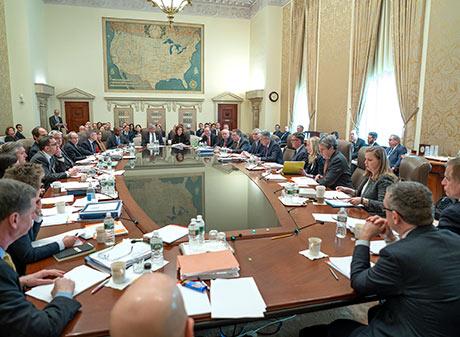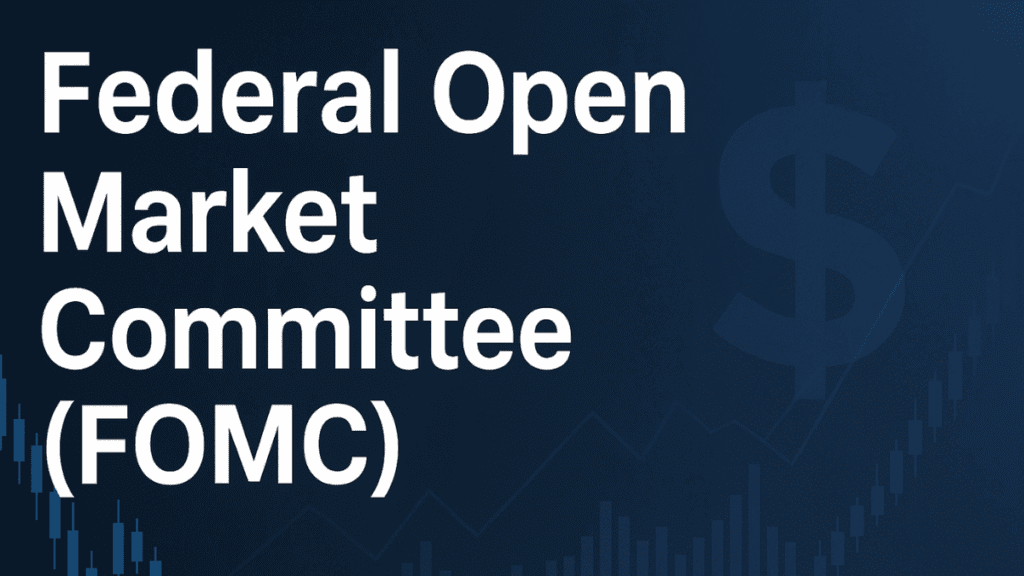The Federal Open Market Committee (FOMC) is the policy-making arm of the U.S. Federal Reserve System responsible for overseeing the nation’s open market operations, which influence interest rates, money supply, and overall economic growth. The FOMC plays a central role in setting monetary policy, making it one of the most influential financial bodies in the world.
Commonly known by its abbreviation FOMC, this committee makes decisions that affect borrowing costs, inflation, employment, and the stability of financial markets worldwide. Traders, investors, and economists closely follow FOMC meetings and announcements, as they often trigger significant movements in stocks, bonds, and currencies.
Key Takeaways
- The Federal Open Market Committee (FOMC) is the policy-making branch of the U.S. Federal Reserve.
- It manages monetary policy by influencing interest rates and the money supply.
- The FOMC consists of 12 voting members who meet eight times a year.
- Its decisions affect inflation, employment, investment, and global financial markets.
- Traders worldwide monitor FOMC announcements for market direction.
- Despite criticisms, the FOMC’s actions remain essential for maintaining economic balance.
Definition and Overview

The Federal Open Market Committee (FOMC) is the branch of the Federal Reserve System tasked with formulating and implementing U.S. monetary policy. Its primary objective is to promote maximum employment, maintain stable prices, and ensure moderate long-term interest rates — collectively known as the Federal Reserve’s dual mandate.
The Federal Reserve System controls the three tools of monetary policy
The Board of Governors of the Federal Reserve System is responsible for the discount rate and reserve requirements, and the Federal Open Market Committee (FOMC) is responsible for open market operations
In simple terms, the FOMC determines whether the economy needs more or less money in circulation. By adjusting interest rates and conducting open market operations (buying or selling government securities), it influences the availability of credit and liquidity in the economy.
The committee meets several times a year to assess economic conditions and decide whether to tighten, loosen, or maintain the current monetary policy.
Composition of the Federal Open Market Committee
The FOMC is composed of 12 voting members, including:
- Seven members of the Federal Reserve Board of Governors are appointed by the President of the United States and confirmed by the Senate.
- The president of the Federal Reserve Bank of New York, who has a permanent voting seat.
- Four of the remaining eleven Reserve Bank presidents serve one-year terms on a rotating basis.
Even though only 12 members vote, all 19 participants (including nonvoting Reserve Bank presidents) contribute to discussions and policy recommendations.
Key Roles
- Chair of the Federal Reserve: Also serves as the FOMC chair and as the public face of U.S. monetary policy.
- Vice Chair of the FOMC: Typically, the president of the New York Fed is responsible for implementing open market operations.
- Voting Members: Decide on interest rate changes and other policy measures.
- Staff Economists: Provide forecasts, models, and data analysis that guide policy decisions.
How the FOMC Works
1. Meetings and Decision-Making
The FOMC typically meets eight times per year, about every six weeks. However, additional meetings can be held if economic conditions change rapidly.
Before each meeting:
- The staff prepares a detailed economic report known as the Greenbook (for forecasts) and Bluebook (for policy alternatives).
- Members review data on GDP growth, inflation, employment, consumer spending, and global economic trends.
During the meeting:
- The committee discusses current economic conditions and policy options.
- They decide whether to raise, lower, or maintain the federal funds rate the benchmark interest rate that influences all other borrowing costs in the economy.
- The decision is followed by a press release and, later, a detailed meeting minutes report that outlines the rationale behind the decision.
2. Open Market Operations
The main tool the FOMC uses is open market operations (OMO) — the buying or selling of U.S. government securities in the open market.
- Buying securities: Adds money to the banking system, lowers interest rates, and stimulates borrowing and spending.
- Selling securities: Withdraws money from circulation, raises interest rates, and helps control inflation.
These operations are carried out by the Trading Desk at the Federal Reserve Bank of New York.
3. Setting the Federal Funds Rate
The federal funds rate is the rate at which banks lend reserves to one another overnight. It’s the cornerstone of U.S. monetary policy.
Changes in this rate affect:
- Mortgage rates
- Credit card interest
- Auto loans
- Business borrowing
- Global capital flows
A higher rate slows economic activity, while a lower rate encourages spending and investment.
Objectives of the FOMC
The Federal Open Market Committee operates under three main objectives:
- Maximum Employment – Ensure that as many Americans as possible have jobs without triggering inflation.
- Stable Prices – Control inflation to preserve the purchasing power of the U.S. dollar.
- Moderate Long-Term Interest Rates – Maintain sustainable economic growth and prevent financial bubbles.
These goals are interlinked. For example, stimulating employment can sometimes increase inflation, requiring careful balancing.
Key Tools of the FOMC
The FOMC has several tools at its disposal to influence monetary conditions:
1. Open Market Operations (OMO)
Buying or selling government bonds to regulate the money supply.
- Expansionary policy → buying bonds → increases liquidity.
- Contractionary policy → selling bonds → decreases liquidity.
2. Federal Funds Rate Target
Adjusting the target range for the federal funds rate influences borrowing costs across the economy.
3. Discount Rate
The interest rate charged by Federal Reserve Banks when commercial banks borrow from them directly. A lower discount rate encourages lending.
4. Reserve Requirements
Rules dictate how much money banks must hold in reserve. Lowering reserve requirements increases lending capacity.
5. Forward Guidance
The FOMC’s communication about future policy intentions guides market expectations and investor behavior.
FOMC and Financial Markets
Every FOMC meeting is a major event in global financial markets. Traders and investors monitor decisions and statements for clues about future economic trends.
1. Impact on the Forex Market
Changes in U.S. interest rates directly affect the value of the U.S. dollar.
- Higher rates → attract foreign investment → strengthen the dollar.
- Lower rates → make the dollar less attractive → weaken it.
For this reason, FOMC announcements often trigger volatility in major currency pairs such as EUR/USD, GBP/USD, and USD/JPY.
2. Impact on the Stock Market
- Rate cuts generally boost stock prices as borrowing becomes cheaper and corporate profits rise.
- Rate hikes can dampen stock performance by increasing costs and reducing future earnings expectations.
3. Impact on Bond Market
The FOMC’s actions have a direct impact on bond yields. When the Fed raises rates, existing bonds lose value, and yields rise.
4. Impact on Commodities
Commodities like gold and oil also react to FOMC policies. For example:
- A strong dollar (due to higher rates) often pushes gold prices down.
- Looser monetary policy can drive commodity prices up due to inflation expectations.
Example: FOMC in Action
Scenario 1 – Fighting Inflation
In 2022, the U.S. experienced its highest inflation in decades. The FOMC responded by raising the federal funds rate multiple times.
Effect: Borrowing costs increased, slowing consumer spending and cooling inflation. However, this also raised concerns about a potential recession.
Scenario 2 – Stimulating the Economy
During the 2008 Financial Crisis and the 2020 COVID-19 pandemic, the FOMC lowered rates to near zero and launched quantitative easing (QE) — large-scale bond purchases to inject liquidity.
Effect: The actions stabilized financial markets, encouraged lending, and supported economic recovery.
These examples highlight the committee’s flexibility in addressing changing economic conditions.
Transparency and Communication
The FOMC values transparency to help financial markets and the public understand its policy direction. It does this through:
- Post-meeting statements summarizing decisions.
- Press conferences led by the Fed Chair.
- Meeting minutes are released three weeks after each session.
- Quarterly economic projections showing forecasts for growth, unemployment, and inflation.
This open communication strategy is vital for maintaining market confidence and credibility.
Criticism and Limitations of the FOMC
While the FOMC plays a crucial role in economic stability, it faces several criticisms:
- Lag Effects: Monetary policy takes time to influence the real economy, often leading to delayed results.
- Market Dependence: Investors sometimes rely too heavily on FOMC actions, creating volatility when expectations differ from outcomes.
- Global Spillover: U.S. policy changes can destabilize emerging markets through capital flight or currency fluctuations.
- Data Dependency: Decisions rely heavily on forecasts and models, which can be inaccurate.
- Political Pressure: Although designed to be independent, the Fed occasionally faces political scrutiny during election periods.
Despite these challenges, the FOMC remains one of the most respected and influential central banking bodies in the world.
Importance of the FOMC for Traders and Investors
For traders and investors, understanding FOMC policy decisions is crucial for navigating market trends.
- Forex traders monitor interest rate changes for currency movements.
- Stock investors use FOMC signals to anticipate market sentiment and adjust portfolios.
- Bond traders analyze FOMC statements to forecast yield curves.
- Commodity traders consider FOMC actions when evaluating inflation risks.
Successful investors pay attention not only to the FOMC’s decisions but also to its tone, wording, and projections often referred to as “Fed speak.”
Conclusion
The Federal Open Market Committee (FOMC) is at the heart of global monetary policy. Its decisions ripple through every sector — from banking and investing to consumer finance and international trade. Understanding how the FOMC operates helps traders, investors, and businesses anticipate market trends and make informed financial decisions.
In a world where interest rates guide economic momentum, the FOMC stands as the guardian of U.S. monetary stability — a body whose every word and action can shape the future of the financial markets.
